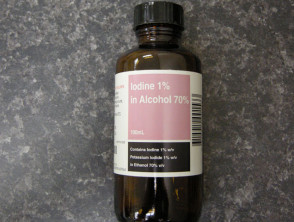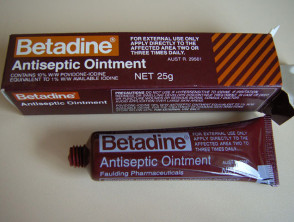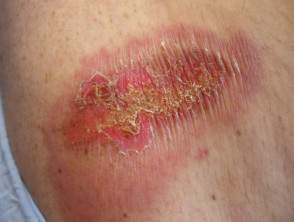What is iodine?
Iodine is a natural element that is essential for all living organisms. Iodine is a member of a group of non-metal elements called halogens; other halogens include fluorine, chlorine and bromine.
What is iodine used for?
Iodine is used topically, orally and by injection:
- Iodine is commonly used in topical antiseptics
- Oral iodine is used in the treatment of some thyroid diseases
- Iodine is used in radiological contrast media for x-rays including CT scans, cholecystograms and pyelograms, either orally or by injection into the bloodstream
Iodine may also be ingested in foods such as seaweed, seafood and iodised salt. Smaller amounts of iodine are found in vegetables and meat.
Iodine
Iodine allergy
The term ‘iodine allergy’ is commonly used, but is actually a misnomer. Iodine is a trace element present throughout the body and is essential for the production of thyroid hormones. It is not possible to have a true allergy to elemental iodine.
‘Iodine allergy’ usually refers to an allergic-type reaction to iodinated radiological contrast media or, less commonly, an allergic contact reaction to povidone-iodine (Betadine™) antiseptics.
Cutaneous reactions to iodinated radiological contrast media
These reactions may be classified as immediate and non-immediate:
- Immediate reactions usually begin within 20 minutes of administration of contrast media and include itch, redness, urticaria (hives), angioedema and anaphylaxis.
- Non-immediate reactions begin more than one hour after administration and include urticaria, angioedema, maculopapular rash or rarely, more severe reactions such as Stevens-Johnson syndrome / toxic epidermal necrolysis.
Newer iodinated contrast media have improved chemical properties and the incidence of these types of reactions is now much lower.
Most of the above reactions to contrast media are not true hypersensitivity reactions (immunoglobulin E antibodies are not involved). The reactions are called idiosyncratic, and unlike true hypersensitivity reactions, a previous sensitisation to the agent is not required, nor do these reactions consistently recur in an individual.
Risk factors for reactions to contrast media
| Risk factor | Management |
|---|---|
| History of a previous reaction to iodinated contrast media |
|
| History of asthma, food allergy, or allergy to other medications |
|
| Significant cardiovascular disease or use of beta-blocker medications |
|
Allergic contact reactions to povidone-iodine
Povidone-iodine is a commonly used antibacterial agent that is a compound of iodine and povidone, along with other additives. Povidone is also used in other products such as foods, medicines (eg, antihistamines, diuretics, and pain-relievers), hair products, and toothpaste.
Allergic contact reactions to povidone-iodine preparations are rare and can be difficult to distinguish from an irritant contact reaction to povidone-iodine. Both reactions can cause redness, induration (firmness) and multiple small blisters.
Patch testing is often used to help diagnose an allergic contact reaction. However, false positive reactions can occur in this instance due to the irritant properties of povidone-iodine under occlusion. When a positive patch test reaction to povidone-iodine does occur, it is important to confirm results with further tests, such as the repeat open application test (ROAT).
Systemic reactions to povidone-iodine antiseptics (e.g. generalised urticaria and anaphylaxis) are extremely rare and are thought to be caused by povidone, rather than iodine.
Cross-reactivity between povidone-iodine antiseptics and iodinated contrast media
- A history of contact allergy to povidone-iodine antiseptics does not specifically preclude the use of iodinated contrast media. However, the risk of a reaction may be increased slightly, as is the case with any other contact allergy.
- Anaphylaxis to povidone-iodine is thought to be caused by povidone, and cross-reactivity between these antiseptics and iodinated contrast media has not been demonstrated.
Other cutaneous reactions to iodine
- A chemical burn-like skin reaction can occur following prolonged skin contact with povidone-iodine saturated drapes during surgery. These reactions have the appearance of electrical burns and are thought to be due to a direct toxic effect of povidone-iodine.
- An acneform eruption due to excessive dietary iodine, for example from seaweed in a Japanese diet
- Halogenoderma – A rare non-allergic skin reaction caused by high levels of halogens in the body.
Iodine ‘burn’ (contact irritant dermatitis)


